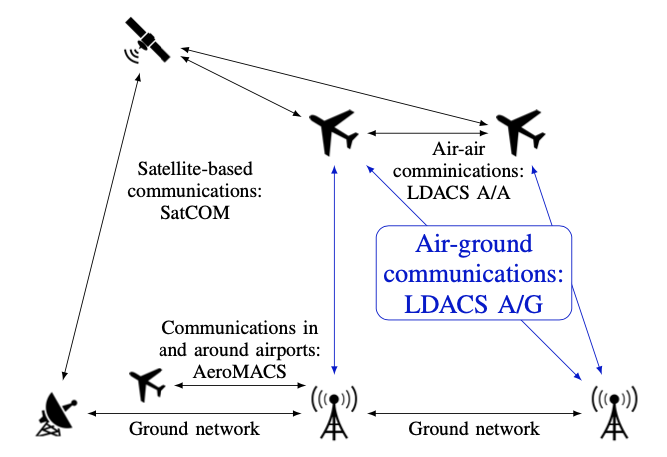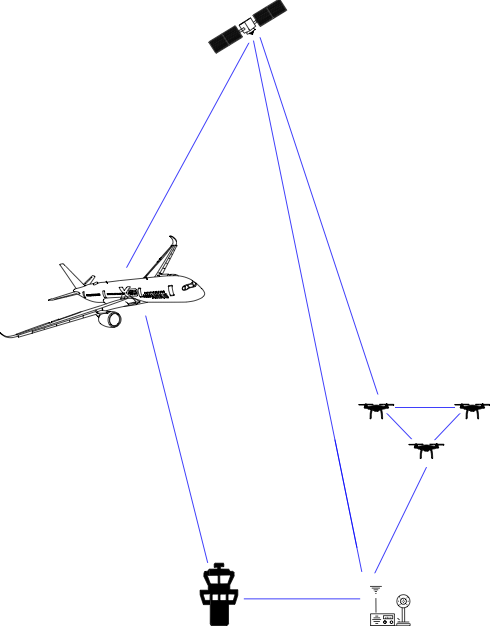Secure Aeronautic Communication
Today digitization does not stop on ground level its importance increases also in aeronautical applications. These include on the one hand the public sector of transportation focusing on communications between aircrafts and ground stations for navigation purposes. On the other hand, its relevance rises also in the private sector as more and more Unoccupied Aerial Vehicles (UAV) become affortable. Thus, the airspace is shared by aircrafts, helicopters, and drones and becomes more and more overcrowded. Further, all of them require secure, reliable, and available communication ensuring flawless operations. Thus, the radio medium itself is a bottlenck and also a attack surface as it is partially unsecured.
The established industry cooperations with the German Aerospace Center (DLR) and Airbus Defense GmbH tackle the aforementioned issues. Here it is important to find a balance between investments, regulations, and requirements for safety and security support. Further, it must kept in mind that a life-cycle of airplanes differ compared to drones and need to ensure secured communication for a long time before updates are possible.
Mutual authentication and key agreement methods for the digital aeronautical ground-based communications system L-band Digital Aeronautical Communication System (LDACS)

As growth of civil air traffic worldwide poses a great challenge for the supporting Communication, Navigation andSurveillance (CNS) infrastructure updates on infrastructure and communication pattern become important, also especially due to the digitization process taken part in aeronautic. Analogue systems have to be replaced by digital means to optimize spectrum efficiency and automation is becoming much more important to be able to handle the amount of participants in the air traffic system. As safety and security are strongly intertwined in aviation, cyber security is one key enabler for digitalization in civil aviation. As such we investigate mutual authentication and key agreement methods for the digital aeronautical ground-based communications system L-band Digital Aeronautical Communication System (LDACS). This started with the definition of a cyber security architecture and now continues with specific security protocol implementations. Thereby, we compare the suitability of three different Diffie-Hellmann (DH) key exchange flavors used in a modified version of the Station-To-Station (STS) protocol, for digital aeronautical communication in terms of latency and security data overhead.We conclude, the STS protocol based on a central Public KeyInfrastructure (PKI) trust solution with Supersingular Isogeny Diffie-Hellman (SIDH) for post-quantum security to be best suited for long term security. However, due to the smaller key sizes, Elliptic Curve Diffie-Hellman (ECDH) is the more resource efficient candidate and may play a role in low resource authentication scenarios for LDACS. The gained insights are currently undergoing the standardization process in ICAO and IETF. Specifications and implementation were published on high ranked conferences and won several awards.
Air Mobility Integration U-Space (AMIUS)
The overall objective of the AMIUS research is to create the first integrated Bavarian U-space connecting the city of Ingolstadt with Manching Airport. In addition to the activities described here, this U-space is available as a real test field for use by Bavarian companies in the eVTOL and UAS industry. The project investigates how a U-space based on digital services can integrate today's air traffic, including its processes and technologies, with future deployment scenarios of UAS and eVTOLs in a common airspace. For this purpose, the required air traffic management functionalities for safe, integrated and efficient operations, will be provided and demonstrated by the U-space services defined by EASA. Based on these digital services, flights within the Manching control zone, for example from the Drone Center to Ingolstadt main station, are planned as concrete use cases. These practical demonstrations will be supported by corresponding scientific model-based preliminary investigations, multimodal simulations with different traffic systems, feasibility studies as well as cost analyses by the participating universities. To guarantee safe and efficient integrated operations of UAS, eVTOLS and general aviation in the future, novel traffic concepts are required. For this purpose, the existing airspace management must be supplemented by an integrated UTM and thus expanded by the dimension of the previously uncontrolled airspace. The focus is on the design and technical implementation of the demonstrator using a UTM system and appropriate ground infrastructures, complemented by innovative communication technologies and a central control station. The project will also investigate how the data flow between the participating airspace users and the storage of relevant data can be secured by various measures against unauthorized external interference.
Safety and security aspects for Unoccupied Aerial Vehicles (UAV) operations

Another research area faces the challenge caused by the increasing occupation of airspace by Unoccupied Aerial Vehicles (UAV). The number of UAVs is projected to exponentially increase in the next few decades for a variety of civil and military uses. However, this poses significant challenges with respect to airspace integration. This situation calls for identifying security vulnerabilities of UAV's communication and airspace management, air-craft communications addressing and reporting system (ACARS), and automatic dependent surveillance-broadcast (ADS-B). With a comprehensive threat model, open questions and challenges were formulated and a concept, called S2UAS, was designed to address safety and security aspects for UAV operations. S2UAS covers four essential aspects:
- Detect incoming aerospace vehicles,
- Authenticate those vehicles and establish a secure communication channel,
- Safely react to failed authentication and
- Enable collaboration such as formation flight, even if vehicles are only partially trustworthy.
